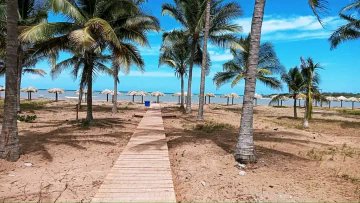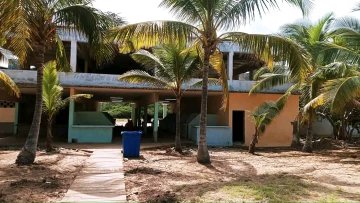 The beginning of Summer 2024 in Guantanamo province has just brought good news, including a long-cherished longing for more than a decade: that Yateritas Beach will once again become the main beach resort for the residents of the Guaso River town.
The beginning of Summer 2024 in Guantanamo province has just brought good news, including a long-cherished longing for more than a decade: that Yateritas Beach will once again become the main beach resort for the residents of the Guaso River town.
In that sun and sea destination, surrounded by natural attractions such as the marine terraces of the so-called Cuban semi-desert in the southern coastal strip of the province, several years ago there were several gastronomic and recreational services for local and foreign visitors, who found there several options to have fun in the summer.
The memories of those times multiply today as the days of intense heat pass and many vacationers plan to enjoy the bathing areas enabled in the local geography.
Let’s remember the damages of natural and anthropogenic origin that affected on several occasions that public space located about 39 kilometers east of the provincial capital, at the mouth of the Yateras River on the south coast of Guantanamo province.
Strong floods of this river torrent in 1993, 1994, 1997 and those caused by hurricanes George in 1998, Sandy in 2012, and Matthew in 2016, dragged large amounts of sand into the sea, thus limiting the capacity of use of the resort.
As a consequence, the infrastructure created in the 60s, 70s and 80s of the last century, which ensured visitors food in a cafeteria-restaurant and accommodation in cabins, were irreversibly damaged, and state agencies and entities that contributed to the fulfillment of the social purpose of this site for public recreation were absent from the place.
With the passage of time, alternatives arose in the neighboring beaches of El Guanal, better known as Doña Yuya, and Tortuguilla, but both are not very sandy and limited in space to accommodate high numbers of vacationers, which were affected on many occasions by overcrowding.
Today, the desolate panorama no longer exists at Yateritas beach thanks to the will of the main political and governmental authorities of the territory and of the state agencies and entities involved in its recovery.

Considerable amounts of garbage, remains of timber trees, and plastic debris were removed from the dune, which is washed up there daily by the thrust of the sea wave trains.
Since 2003, Yateritas beach has been undergoing a progressive stage of rebirth, with a notable recovery of its ecosystem values, thanks to the implementation and development of a project financed by the National Environmental Fund.
The plan was materialized by the Center of Technological Applications for Sustainable Development (CATEDES), attached to the provincial delegation of the Ministry of Science, Technology and Environment.
The implementation of the project eliminated the casuarina forest, an invasive exotic species that accelerated erosion and instability of the beach sand, and the area was reforested with native plants, including coconut trees and caleta grapes.
These actions contributed to the reconformation of the beach profile and the improvement of the visual quality of the landscape, with the massive appearance of plant species such as the beach sweet potato and sand-supporting grasses.
Also, mangrove repopulation and care measures were applied in areas that were razed five kilometers upstream of the Yateras River hydro-regulating strip, where two hectares of guayacán and ocuje were planted on the riverbanks.
At present, new rustic wooden facilities resistant to earthquakes, hurricanes and heavy rains are being built there, with the use of environmentally friendly materials, actions that favor the exchange of sand and water between the sea and the inner lagoon, located a few meters from the beach.
Despite the serious damage caused in October 2016 by Hurricane Matthew, there is consensus among the Guantanamo environmental community that Yateritas beach is optimal for use as a bathing area, from the technical point of view.
It is evident the self-recovery capacity of the dune in the face of natural disasters, improvements in environmental quality, decrease in the tendency to desertification, renewal of biological diversity and the total reestablishment of the natural shaded area.

The protection and recovery of eroded beaches, to protect them from the aggressions of nature and human beings, is part of the Tarea Vida, a governmental plan aimed at mitigating the impact of climate change.
That is why it is up to the competent authorities of the Guantanamo and San Antonio del Sur municipalities to carry out systematic environmental sanitation works and carry out studies to determine the beach’s load capacity, in order to apply effective controls on the number of bathers concentrated in the moments of greater affluence of visitors, so that Yateritas lasts in time as the most important recreational center par excellence for Guantanamo people.
It is also necessary to maintain an adequate order in the place, with emphasis on the Urban Planning Regulations as an instrument of management and control, not only of the plans, but of all the transformations in the beach.
With the beginning of summer, it is the responsibility of vacationers to contribute to the care of the new facilities, to keep them clean, to protect the environment and to practice mutual respect so that social indiscipline does not proliferate to the detriment of the enjoyment of all, and it is up to the local authorities to ensure compliance with the Law.
Translated and edited by Dayla Perez Ortiz.